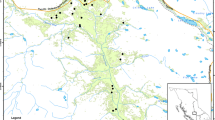Abstract
Data from the long-term experiment on sheep grazing versus zero sheep grazing (i.e. in an enclosure) on the composition of the Juncus squarrosus grassland at the Moor House NNR are presented. The data have been analysed to assess change in (1) the abundance of individual species, (2) higher plant and bryophyte communities, and (3) vegetation structure. The higher plant data suggested that both the enclosed-and grazed plots were changing in the same direction, but the enclosed plot was moving much faster. The general tendency was towards a blanket bog vegetation dominated by Eriophorum vaginatum and Calluna vulgaris. Juncus squarrosus has declined very quickly in the enclosed plot, but there has also been a slower decline in the grazed one. A significant increase in Calluna vulgaris has occurred only in the enclosed plot. In contrast, the bryophyte data showed completely different successional trajectories in the two treatment plots.
The vegetation structure changed markedly after release from grazing, with a decrease in phytomass, but increase in necromass in the lowest height strata. There was no noticeable change in structure over the 18 year period in the grazed plot.
Particular problems found in this study were that some species either fluctuated widely in response, or changed in a curvilinear manner.
Similar content being viewed by others
References
Austin, M. P., Williams, O. B. & Belbin, L. 1981. Grassland dynamics under sheep grazing in an Australian Mediterranean type climate. Vegetatio 47: 201–211.
Bakker, J. P. 1985. The impact of grazing on plant communities, plant populations and soil conditions on salt marshes. Vegetatio 62: 391–398.
Dixon, W. J. & Mood, A. M. 1946. The statistical sign test. J. Amer. Stat. Ass. 41: 557–566.
Eddy, A., Welch, D. & Rawes, M. 1969. The vegetation of the Moor House Nature Reserve in the northern Pennines, England. Vegetatio 16: 239–284.
Gibson, C. W. D., Dawkins, H. C., Brown, V. K. & Jepsen, M. 1987. Spring grazing by sheep: effects on seasonal changes during old field succession. Vegetatio 70: 33–43.
Heal, O. W. & Smith, R. A. H. 1978. Introduction and site description. In: Heal, O. W. & Perkins, D. F. (eds), Production ecology of British moors and montane grasslands, pp. 3–16. Springer Verlag, Berlin.
Hewett, D. G. 1985. Grazing and mowing as management tools on dunes. Vegetatio 62: 441–447.
Hobbs, R. J. 1984. Length of burning rotation and community composition in high-level Calluna-Eriophorum bog in N England. Vegetatio 57: 129–136.
Jensen, A. 1985. The effect of cattle and sheep grazing on saltmarsh vegetation at Skallingen, Denmark. Vegetatio 60: 37–48.
Lee, J. A., Tallis, J. H. & Woodin, S. J. in press. Acidic deposition and British upland vegetation. In: Usher, M. B. & Thompson, D. B. A. (eds), Ecological change in the uplands. Blackwell, Oxford.
Marrs, R. H., Rawes, M., Robinson, J. S. & Poppitt, S. D. 1986. Long-term studies of vegetation change at Moor House NNR: guide to recording methods and database. Merlewood Research and Development Paper No. 109. ITE, Grange over Sands.
Miles, J. 1979. Vegetation dynamics. Chapman & Hall, London.
Pearsall, W. H. 1950. Mountains and moorlands. Collins, London.
Rawes, M. 1981. Further results of excluding sheep from high-level grasslands in the north Pennines. J. Ecol. 69: 651–669.
Rawes, M. 1983. Changes in two high altitude blanket bogs after the cessation of sheep grazing. J. Ecol. 71: 219–235.
Rawes, M. & Heal, O. W. 1978. The blanket bog as part of a Pennine moorland. In: Heal, O. W. & Perkins, D. F. (eds), Production ecology of british moors and montane grasslands, pp. 224–246. Springer-Verlag, Berlin.
Rawes, M. & Hobbs, R. J. 1979. Management of semi-natural blanket bog in the northern Pennines. J. Ecol. 67: 789–807.
Rawes, M. & Welch, D. 1969. Upland productivity of vegetation and sheep at Moor House National Nature Reserve, Westmorland, England. Oikos Suppl. 11: 1–72.
Slim, P. & Oosterveld, P. 1985. Vegetation development on newly embanked sandflats in the Grevelingen (The Netherlands) under different management practices. Vegetatio 62: 407–414.
Ter Braak, C. J. F. 1987a. CANOCO—a FORTRAN program for canonical community ordination by partial detrended canonical correspondence analysis, principal components analysis and redundancy analysis (version 2.1). TNO Institute of applied computer science, Wageningen.
Ter Braak, C. J. F. 1987b. The analysis of vegetation-environment relationships by Canonical Correspondence Analysis. Vegetatio 69: 69–77.
Watt, A. S. 1981a. A comparison of grazed and ungrazed grassland A in East Anglian Breckland. J. Ecol. 69: 499–508.
Watt, A. S. 1981b. Further observations on the effects of excluding rabbits from grassland A in East Anglian Breckland: the pattern of change and factors affecting it (1936–73). J. Ecol. 69: 509–536.
Welch, D. & Rawes, M. 1964. The early effects of excluding sheep from high level grasslands in the north Pennines. J. appl. Ecol. 1: 281–300.
Wells, T. C. E. 1980. Management options for lowland grassland. In: Rorison, I. H. & Hunt, R. (eds), Amenity grass: an ecological perspective, pp. 175–196. Wiley, Chichester.
Woodin, S. J. in press. Acidic deposition and upland conservation—an overview and the way ahead. In: Usher, M. B. & Thompson, D. B. A. (eds), Ecological change in the uplands. Blackwells, Oxford.
Author information
Authors and Affiliations
Rights and permissions
About this article
Cite this article
Marrs, R.H., Bravington, M. & Rawes, M. Long-term vegetation change in the Juncus squarrosus grassland at Moor House, northern England. Vegetatio 76, 179–187 (1988). https://doi.org/10.1007/BF00045478
Accepted:
Issue Date:
DOI: https://doi.org/10.1007/BF00045478




